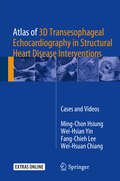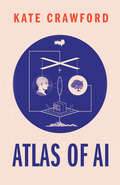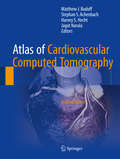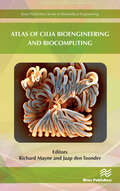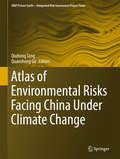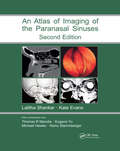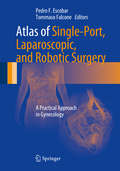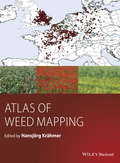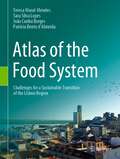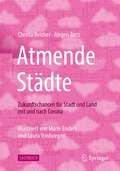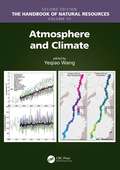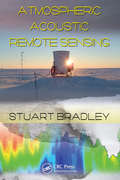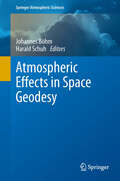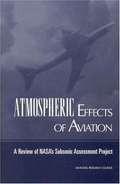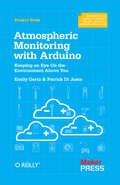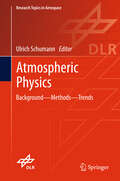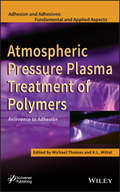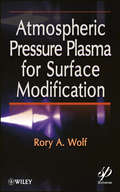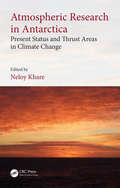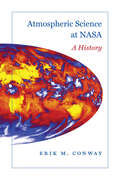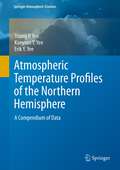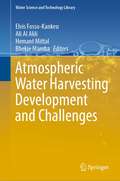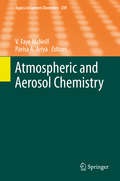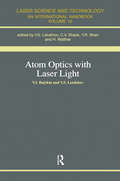- Table View
- List View
Atlas of 3D Transesophageal Echocardiography in Structural Heart Disease Interventions: Cases And Videos
by Wei-Hsian Yin Ming-Chon Hsiung Fang-Chieh Lee Wei-Hsuan ChiangUses over 500 to demonstrate various cardiovascular pathologies.<P><P> All of the delicate pictures were captured, reconstructed, and analysed by well-experienced senior physicians and cardiovascular imaging specialists.<P> All 40 cases are written in the uniform structure and easily readable way.<P>This book introduces classic and unique cases in 3D TEE in structural heart disease interventions. In each all the 40 cases, background information, clinical presentations, and diagnostic findings are present and followed by step-by-step approaches of interventional therapies and outcomes after the procedures. The highlight of the book is to utilize extensive illustrations, over 500, to demonstrate various cardiovascular pathologies. Most of the figures are 3D transesophageal echocardiograms, they are cooperated with 2D transesophageal echocardiograms, X rays, fluoroscopies, computed tomograms, etc. Since the echo images obtained in clinic practice are moving images, it also includes over 300 videos, which serve as a supplement to the static illustrations in this book.<P> The atlas is organized into five chapters. In Chapters one, cases received closure of congenital and acquired cardiac defects are described. Transcatheter aortic valve implantation and its complications are discussed in Chapter two and three. Chapter four details the valve-in-valve therapy. Chapter five covers MitraClip therapy. It offers readers an insider’s view of 3D transesophageal echocardiography in structural heart disease interventions and to refresh their clinical work.
Atlas of AI: Power, Politics, and the Planetary Costs of Artificial Intelligence
by Kate CrawfordThe hidden costs of artificial intelligence, from natural resources and labor to privacy, equality, and freedom&“Eloquent, clear and profound—this volume is a classic for our times. It draws our attention away from the bright shiny objects of the new colonialism through elucidating the social, material and political dimensions of Artificial Intelligence.&”—Geoffrey C. Bowker, University of California, Irvine What happens when artificial intelligence saturates political life and depletes the planet? How is AI shaping our understanding of ourselves and our societies? In this book Kate Crawford reveals how this planetary network is fueling a shift toward undemocratic governance and increased racial, gender, and economic inequality. Drawing on more than a decade of research, award‑winning science, and technology, Crawford reveals how AI is a technology of extraction: from the energy and minerals needed to build and sustain its infrastructure, to the exploited workers behind &“automated&” services, to the data AI collects from us. Rather than taking a narrow focus on code and algorithms, Crawford offers us a political and a material perspective on what it takes to make artificial intelligence and where it goes wrong. While technical systems present a veneer of objectivity, they are always systems of power. This is an urgent account of what is at stake as technology companies use artificial intelligence to reshape the world.
Atlas of Cardiovascular Computed Tomography (2nd Edition): Includes Narrated Videos
by Jagat Narula Matthew J. Budoff Stephan S. Achenbach Harvey S. HechtIncludes nearly 1000 high quality images in step with the latest developments.<P><P> Contributors include world-renowned authors from a variety of disciplines.<P> Includes high-quality hand-drawn illustrations.<P> Offers in-depth explanation for each image.<P> This atlas is a comprehensive visual reference for the use of cardiovascular computed tomography (CT) containing photomicrographs, anatomic illustrations, tables, and charts paired with extensive legends and explanations that are supplemented by extensive research, peer-reviewed articles, and textbooks.<P> In addition to providing historical perspective and current direction for CT, this new edition of Atlas of Cardiovascular Computed Tomography 2e focuses on research involving coronary artery diseases and anomalies, congestive heart failure, atherosclerotic plaques and asymptomatic disease, as well as imaging techniques, including preparation, acquisition, and processing, involving the great vessels and carotids, the peripheral vasculature, and coronary and pulmonary veins. The increasing role of CT in the emergency room and in private cardiology practice is also reviewed thoroughly, making this an essential read for all involved in cardiac imaging, cardiology and emergency medicine.
Atlas of Cilia Bioengineering and Biocomputing
by Richard Mayne Jaap Den ToonderCilia are microscopic finger-like cell-surface organelles possessed by a great many eukaryotic organisms, including humans, whose purposes include generating local fluid movements via rhythmic whip-like beating and environmental sensing. Despite intense research efforts since their discovery by van Leeuwenhoek in the 1670's, several key questions regarding ciliary functions, experimental manipulation and in silico imitation remain unanswered. Major justifications for cilia research lie in their involvement in various forms of human disease (ciliopathies) and their ability to instantiate decentralised, asynchronous sensorial-actuation of adjacent matter through modulation of beating characteristics. Further elucidation of these characteristics, which is a problem requiring the combined expertise of mathematicians, computer scientists, engineers and life scientists, will lead to novel biomedical therapies, creation of `smart' actuating surfaces for microfluidics/lab-on-chip applications and a greater understanding of fluid mechanics in real-world scenarios. This lavishly-illustrated anthology presents recent advances in the fields of ciliary investigation, manipulation, emulation, mimesis and modelling from key researchers in their fields: its goal is to explain the state-of-the-art in cilia bioengineering and bio-computation in a uniquely creative, accessible manner, towards encouraging further transdisciplinary work in the field as well as educating a broad spectrum of scientists and lay people. The volume is split into three distinct but interwoven themes:Biology: Biological preliminaries for the study of cilia; the state-of-the-art in genetic engineering of ciliated cells for biomedical purposes; reprogramming of cilia dynamics in live cells.Engineering: Creation of macro cilia robots for object sorting applications; pneumatic cilia for the optimization of fluid motion; electrostatic, magnetic and MEMS cilia for microfluidic mixing; reviews in artificial cilia fabrication, actuation and flow induction methods.Numerical and computational modelling. Analyses of thin film cilia for `lab on chip' microfluidic mixing applications; modelling of gel-based artificial cilia towards simulating dynamic behaviors of responsive cilia layers in complex fluids across a wide range of potential applications.
Atlas of Emergency Ultrasound
by John Christian FoxEmergency medicine specialists explain how to use the new mobile ultrasound systems at bedside to help with diagnosis in emergency departments. They consider such topics as the focused assessment of sonography in trauma, ultrasound of the lung, pelvic ultrasound, ultrasound-guided procedures, and venous ultrasound. Annotation ©2012 Book News, Inc. , Portland, OR (booknews. com)
Atlas of Environmental Risks Facing China Under Climate Change (IHDP/Future Earth-Integrated Risk Governance Project Series)
by Qiuhong Tang Quansheng GeThis atlas provides the most comprehensive and accurate overview of environmental risks relating to climate change vulnerability and adaptation in China. It addresses the agricultural, ecosystem and heat wave health risk posed by climate change and presents the projected environmental risks in the 21st century under climate change and socioeconomic scenarios. The detailed and concise risk assessments are mapped in grid units, allowing easy environmental risk assessment for specific locations. The atlas contributes significantly to the knowledge base for climate change adaptation in China and is a valuable resource for students and professionals in the fields of geographic sciences and climate change.
Atlas of Imaging of the Paranasal Sinuses, Second Edition
by Kate Evans, Thomas R. Marotta, Eugene Yu, Michael Hawke and Heinz StammbergerWith color illustrations, the Second Edition of this best-selling guide concentrates on the advances in technology that are now available to the clinical otolaryngologist. This reinforces the book's position as a classic guide, especially to the problems associated with endoscopic sinus surgery.
Atlas of Single-Port, Laparoscopic, and Robotic Surgery: A Practical Approach in Gynecology
by Tommaso Falcone Pedro F. EscobarMinimally invasive surgery has become the standard treatment for many diseases and conditions. In the last decade, numerous studies have demonstrated that laparoscopic approaches have improved patients' quality of life if compared with standard open procedures. Atlas of Single-Port, Laparoscopic, and Robotic Surgery serves as a guide in single-port, standard laparoscopy, and robotic surgery and shows how novel techniques, such as single-port laparoscopy and robotics, have recently evolved. The atlas illustrates the unique challenges that the new single-port surgery modality presents, including instruments crowding and articulation, and the advanced laparoscopic skills required to perform these procedures, such as the ability to move and control a flexible camera. It also illustrates how to efficiently and safely utilize the robot to perform most gynecologic procedures. This exceptional resource provides students, residents, fellows, operating room personnel, and practicing gynecologic surgeons with invaluable information about instrumentation, surgical technique, port systems, and the current research and development in robotics.
Atlas of Weed Mapping
by Hansjoerg KraehmerWeeds are variously defined as plants growing where they are not wanted, plants that interfere with human activity. Weeds affect everyone in the world by reducing crop yield and quality, delaying or interfering with harvesting, interfering with animal feeding, reducing animal health, preventing water flow, as plant parasites, etc. It is estimated that those problems cause $ billions worth of crop losses annually and the global cost of controlling weeds also runs into many $ billions every year. Atlas of Weed Mapping presents an introductory overview on the occurrence of the most common weeds of the world. The book notably includes: Description of cropping practices and explanations for the global distribution of weeds Invasive plant mapping Aquatics and wetland plants with histological plant details Theoretical and practical aspects of weed mapping Aspects on the documentation of herbicide resistance Biodiversity, rare weeds and the dominance of the most common weeds Fully illustrated with more than 800 coloured figures and a number of tables, this new characterisation of anthropogenic vegetation will be interesting for readers of a great number of disciplines such as agriculture, botany, ecology, geobotany and plant community research. More than a hundred experts have contributed data to this unique compilation.
Atlas of the Food System: Challenges for a Sustainable Transition of the Lisbon Region
by Teresa Marat-Mendes Sara Silva Lopes João Cunha Borges Patrícia Bento d'AlmeidaThis book is a visual guide to the territorial dynamics operating within a territory. The reading of such dynamics is fundamental in understanding the role of food in cities. This atlas provides a refreshing approach to the study of the city and of its territory, expanded from the perspective of the food system. This book illustrates the impacts of urban planning options on the function of the contemporary Food System of the Lisbon Region, while disclosing its associated urban form solutions. It provides a possible methodology for the reading of the food system based on an analysis of planning instruments and their morphological outcomes, both in the territory but also on the various built forms which have resulted over time. A key focus of the atlas is exploring how planning has regulated the evolution of the Lisbon Region since the 20th century and its implications on the food system. The atlas results from an exhaustive survey and research work conducted in Lisbon Metropolitan Area for a research project, SPLACH – Spatial Planning for Change, for the past 3 years, in terms of the analysis of its Food System and Urban Planning, aiming to inform the delineation of planning strategies towards a sustainable urban environment. It is an important reference for planners, architects, planning and architecture students as well as municipal technicians and the general public, as it provides a refreshing and useful source of information to support further readings about the food system and its relations to urban planning instruments and urban form solutions. Furthermore, it builds a contemporary reading about possible solutions to promote a sustainable transition of the current food systems, while enhancing the strategic role of planning and urban form.
Atmende Städte: Zukunftschancen für Stadt und Land mit und nach Corona
by Christa Reicher Jürgen TietzDie dramatische Sars-CoV-2 Pandemie wirkt weltweit in vielen Bereichen des Lebens wie ein Brandbeschleuniger. Davon sind auch Architektur und Städtebau betroffen. Der Handel in den Innenstädten ist weggebrochen, die Bedeutung von Büros nimmt ab. Dafür werden mehr Grünflächen für die Erholung benötigt und veränderte Wohnungsgrundrisse, um das Homeoffice aufzunehmen. Das Buch benennt die wichtigsten architektonischen und städtebaulichen Veränderungen, die mit Corona in Stadt und Land einhergehen, stellt sie in den Kontext des Stadtumbaus durch den Klimawandel, verortet sie historisch und leitet daraus konkrete Strategien und Chancen ab, um den zentralen Zukunftsherausforderungen zu begegnen, die sich aus der Pandemie für Stadt und Land ergeben.
Atmosphere and Climate
by Yeqiao WangAuthored by world-class scientists and scholars, The Handbook of Natural Resources, Second Edition, is an excellent reference for understanding the consequences of changing natural resources to the degradation of ecological integrity and the sustainability of life. Based on the content of the bestselling and CHOICE-awarded Encyclopedia of Natural Resources, this new edition demonstrates the major challenges that the society is facing for the sustainability of all well-being on the planet Earth. The experience, evidence, methods, and models used in studying natural resources are presented in six stand-alone volumes, arranged along the main systems of land, water, and air. It reviews state-of-the-art knowledge, highlights advances made in different areas, and provides guidance for the appropriate use of remote sensing and geospatial data with field-based measurements in the study of natural resources. Volume 6, Atmosphere and Climate, covers atmospheric pollution and the complexity of atmospheric systems and their interactions with human activity. As an excellent reference for fundamental information on air systems, the handbook includes coverage of acid rain and nitrogen deposition, air pollutants, elevated carbon dioxide, atmospheric circulation patterns, and climate change effects on polar regions and climatology. New in this edition are discussions on aerosols monitoring and mapping, greenhouse gases, the Greenland ice sheet, and mountainous regions. This book presents the key processes, methods, and models used in studying the impact of air pollution on ecosystems worldwide. Written in an easy-to-reference manner, The Handbook of Natural Resources, Second Edition, as individual volumes or as a complete set, is an essential reading for anyone looking for a deeper understanding of the science and management of natural resources. Public and private libraries, educational and research institutions, scientists, scholars, and resource managers will benefit enormously from this set. Individual volumes and chapters can also be used in a wide variety of both graduate and undergraduate courses in environmental science and natural science at different levels and disciplines, such as biology, geography, earth system science, and ecology.
Atmospheric Acoustic Remote Sensing: Principles and Applications
by Stuart BradleySonic Detection and Ranging (SODAR) systems and Radio Acoustic Sounding Systems (RASS) use sound waves to determine wind speed, wind direction, and turbulent character of the atmosphere. They are increasingly used for environmental and scientific applications such as analyzing ground-level pollution dispersion and monitoring conditions affecting wi
Atmospheric Effects in Space Geodesy (Springer Atmospheric Sciences)
by Harald Schuh Johannes BöhmVarious effects of the atmosphere have to be considered in space geodesy and all of them are described and treated consistently in this textbook. Two chapters are concerned with ionospheric and tropospheric path delays of microwave and optical signals used by space geodetic techniques, such as the Global Navigation Satellite Systems (GNSS), Very Long Baseline Interferometry (VLBI), or Satellite Laser Ranging (SLR). It is explained how these effects are best reduced and modelled to improve the accuracy of space geodetic measurements. Other chapters are on the deformation of the Earth's crust due to atmospheric loading, on atmospheric excitation of Earth rotation, and on atmospheric effects on gravity field measurements from special satellite missions such as CHAMP, GRACE, and GOCE. All chapters have been written by staff members of the Department of Geodesy and Geoinformation at TU Wien who are experts in the particular fields.
Atmospheric Effects of Aviation: A Review of NASA's Subsonic Assessment Project
by Panel on Atmospheric Effects of AviationA review of the Atmospheric Effects of Aviation
Atmospheric Monitoring with Arduino: Building Simple Devices to Collect Data About the Environment
by Emily Gertz Patrick Di JustoMakers around the globe are building low-cost devices to monitor the environment, and with this hands-on guide, so can you. Through succinct tutorials, illustrations, and clear step-by-step instructions, you’ll learn how to create gadgets for examining the quality of our atmosphere, using Arduino and several inexpensive sensors.Detect harmful gases, dust particles such as smoke and smog, and upper atmospheric haze—substances and conditions that are often invisible to your senses. You’ll also discover how to use the scientific method to help you learn even more from your atmospheric tests.Get up to speed on Arduino with a quick electronics primerBuild a tropospheric gas sensor to detect carbon monoxide, LPG, butane, methane, benzene, and many other gasesCreate an LED Photometer to measure how much of the sun’s blue, green, and red light waves are penetrating the atmosphereBuild an LED sensitivity detector—and discover which light wavelengths each LED in your Photometer is receptive toLearn how measuring light wavelengths lets you determine the amount of water vapor, ozone, and other substances in the atmosphereUpload your data to Cosm and share it with others via the Internet"The future will rely on citizen scientists collecting and analyzing their own data. The easy and fun gadgets in this book show everyone from Arduino beginners to experienced Makers how best to do that."--Chris Anderson, Editor in Chief of Wired magazine, author of Makers: The New Industrial Revolution (Crown Business)
Atmospheric Physics: Background – Methods – Trends (Research Topics in Aerospace)
by Ulrich SchumannOn the occasion of the 50th anniversary of the Institute of Atmospheric Physics of the German Aerospace Center (DLR), this book presents more than 50 chapters highlighting results of the institute's research.The book provides an up-to-date, in-depth survey across the entire field of atmospheric science, including atmospheric dynamics, radiation, cloud physics, chemistry, climate, numerical simulation, remote sensing, instruments and measurements, as well as atmospheric acoustics. The authors have provided a readily comprehensible and self-contained presentation of the complex field of atmospheric science. The topics are of direct relevance for aerospace science and technology. Future research challenges are identified.
Atmospheric Pressure Plasma Treatment of Polymers: Relevance to Adhesion
by Michael Thomas K. L. MittalThe Atmospheric Pressure Plasma (APP) treatment for polymer surface modification has attracted much attention recently, owing to its advantages over other techniques and its ability to improve adhesion without tampering with polymer's bulk properties. Focusing on the utility of APP treatment for enhancing polymer adhesion, this book covers the latest development in this important and enabling technology, providing profound insights from many top researchers on the design and functions of various types of reactors, as well as current and potential applications of APP treatment.
Atmospheric Pressure Plasma for Surface Modification
by Rory A. WolfThis Book's focus and intent is to impart an understanding of the practical application of atmospheric plasma for the advancement of a wide range of current and emerging technologies. The primary key feature of this book is the introduction of over thirteen years of practical experimental evidence of successful surface modifications by atmospheric plasma methods. It offers a handbook-based approach for leveraging and optimizing atmospheric plasma technologies which are currently in commercial use. It also offers a complete treatment of both basic plasma physics and industrial plasma processing with the intention of becoming a primary reference for students and professionals. The reader will learn the mechanisms which control and operate atmospheric plasma technologies and how these technologies can be leveraged to develop in-line continuous processing of a wide variety of substrates. Readers will gain an understanding of specific surface modification effects by atmospheric plasmas, and how to best characterize those modifications to optimize surface cleaning and functionalization for adhesion promotion. The book also features a series of chapters written to address practical surface modification effects of atmospheric plasmas within specific application markets, and a commercially-focused assessment of those effects.
Atmospheric Research in Antarctica: Present Status and Thrust Areas in Climate Change
by Neloy KhareAtmospheric Research in Antarctica: Present Status and Thrust Areas in Climate Change represents a panoramic view of the developments in the field of Antarctic atmospheric sciences and meteorology broadly covering geomagnetism and aeronomy, middle atmospheric studies and global and climate change studies. It includes greenhouse gases, ozone monitoring as well as very low frequency (VLF) phenomena, and space weather, Antarctic meteorology, and mathematical modeling of atmosphere and ocean processes around Antarctica. Atmospheric electricity and aerosols investigations over Antarctica along with the total solar eclipse-related studies, calibration of AWIFS Sensor, and measurements of positive ions, are also discussed. This book is aimed at researchers and graduate students in atmospheric studies, meteorology, Antarctic studies, climate change. FEATURES: Covers scientific aspects of Antarctic meteorology and atmospheric sciences under climate change scenario Contains diverse set of information with strong bearing on recent and past polar processes Presents integrated research on polar science coupled with meteorological, climatological and atmosphericsciences Thoroughly reviews geomagnetism and aeronomy, middle atmospheric studies including global and climate change studies Helps readers understand how Antarctica’s climate has changed in the past and is being affected by ‘global warming’ and how might we expect its climate to change in the future?
Atmospheric Science at NASA: A History (New Series in NASA History)
by Erik M. ConwayHonorable Mention, 2008 ASLI Choice Awards. Atmospheric Science Librarians InternationalThis book offers an informed and revealing account of NASA’s involvement in the scientific understanding of the Earth’s atmosphere. Since the nineteenth century, scientists have attempted to understand the complex processes of the Earth’s atmosphere and the weather created within it. This effort has evolved with the development of new technologies—from the first instrument-equipped weather balloons to multibillion-dollar meteorological satellite and planetary science programs. Erik M. Conway chronicles the history of atmospheric science at NASA, tracing the story from its beginnings in 1958, the International Geophysical Year, through to the present, focusing on NASA’s programs and research in meteorology, stratospheric ozone depletion, and planetary climates and global warming. But the story is not only a scientific one. NASA’s researchers operated within an often politically contentious environment. Although environmental issues garnered strong public and political support in the 1970s, the following decades saw increased opposition to environmentalism as a threat to free market capitalism. Atmospheric Science at NASA critically examines this politically controversial science, dissecting the often convoluted roles, motives, and relationships of the various institutional actors involved—among them NASA, congressional appropriation committees, government weather and climate bureaus, and the military.
Atmospheric Temperature Profiles of the Northern Hemisphere: A Compendium of Data (Springer Atmospheric Sciences)
by Young Yee Erik Y. Yee Kueyson Y. YeeFor more than three decades, the US Standard Atmosphere has been used by researchers and professionals in many areas of aeronautics and atmospheric sciences. It is an idealized, all season average temperature profile of the earth's atmosphere. But today's modern day and sophisticated global applications require more extensive representations of the mean temperature profile. This book is a global augmentation of the climatological tropospheric temperature profiles in the Northern Hemisphere for different latitude belts and seasons. There are 72 mean temperature profile tables from the surface up to 10 kilometers in height that represent the four seasons for different latitudinal belts (5° N, 10° N , 15° N, 20° N, 25° N, 30° N, 35° N, 40° N, 45° N, 50° N, 55° N, 60° N, 65° N, 70° N, 75° N, 80° N, 85° N). The model is based on a neural network algorithm that uses archived radiosonde data, retrieved temperature profiles from remote sensors, and the solar insolation at the top of the earth's atmosphere. It is the most comprehensive book of mean seasonal tropospheric temperature profiles to date. It will be an indispensible reference to the aeronautic and meteorological industries worldwide as well as an easy-to-use guide for climatologists, meteorologists, aeronautic engineers, researchers and aviators.
Atmospheric Water Harvesting Development and Challenges (Water Science and Technology Library #122)
by Elvis Fosso-Kankeu Bhekie Mamba Ali Al Alili Hemant MittalThe commercial operation of atmospheric water harvesting systems is still limited to few countries; this is mainly due to the low energy efficiency of the system and the inability to effectively operate throughout the various seasons of the year. Researchers have attempted to develop strategies to render the operation of atmospheric water harvesters easier and cost effective. This book covers work progress toward such direction, including among others the co-operation of these systems with renewable energy source and the adaptation of the systems to local conditions; the response of the communities around the world to such technology and how its implementation is affected by cultural believe, cost, and technological friendliness. The book is of interest to academic researchers, students, water authorities, professional in relevant industries, government regulatory bodies officers, and environmentalists.
Atmospheric and Aerosol Chemistry (Topics in Current Chemistry #339)
by V. Faye Mcneill Parisa A. AriyaChristian George, Barbara D'Anna, Hartmut Herrmann, Christian Weller, Veronica Vaida, D. J. Donaldson, Thorsten Bartels-Rausch, Markus Ammann - Emerging Areas in Atmospheric Photochemistry. Lisa Whalley, Daniel Stone, Dwayne Heard - New Insights into the Tropospheric Oxidation of Isoprene: Combining Field Measurements, Laboratory Studies, Chemical Modelling and Quantum Theory. Neil M. Donahue, Allen L. Robinson, Erica R. Trump, Ilona Riipinen, Jesse H. Kroll - Volatility and Aging of Atmospheric Organic Aerosol. P. A. Ariya, G. Kos, R. Mortazavi, E. D. Hudson, V. Kanthasamy, N. Eltouny, J. Sun, C. Wilde - Bio-Organic Materials in the Atmosphere and Snow: Measurement and Characterization. V. Faye McNeill, Neha Sareen, Allison N. Schwier - Surface-Active Organics in Atmospheric Aerosols.
Atom Optics with Laser Light (Laser Science And Technology Ser.)
by V.S. LetokhovThis book deals specifically with the manipulation of atoms by laser light, describing the focusing, channeling and reflection of atoms by laser fields. It also describes the potential fields required to cause the phase change of the wave function necessary for the atomic interactions to occur.
